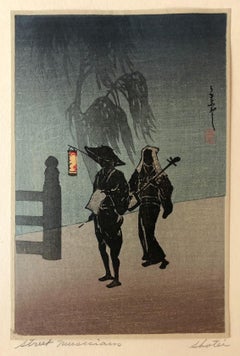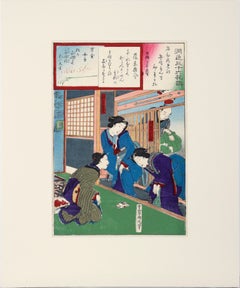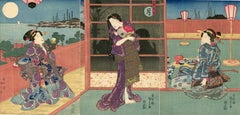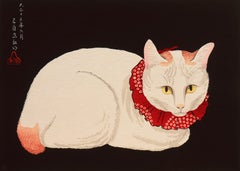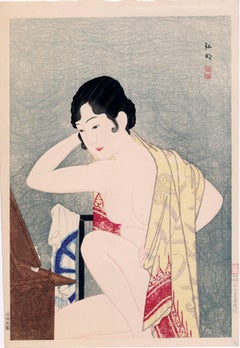Takahashi Hiroaki (Shotei). Art
Japanese, 1871-1945
Born in Tokyo in 1871, Hiroaki Takahashi was working as an artist in an official capacity at an incredibly young age. After an early apprenticeship with his uncle, Matsumoto Fuko (who awarded the young boy the name Shôtei), Takahashi was hired by the Imperial Household Department of Foreign Affairs to copy designs for ceremonial objects.
By the age of 18, Shôtei was a co-founder of the Japan Youth Painting Society, and by 1907 he had been recruited by Shōzoburō Watanabe to produce prints for his Shin Hanga movement. The Shin Hanga ("New Print") movement served to satisfy the widespread demand in the Western world for the export of traditional Ukiyo-e prints in the style of masters like Hiroshige. Shôtei enjoyed tremendous success in this endeavor, however, it was cut devastatingly short in 1923.
On September 1st of 1923, the Great Kanto Earthquake, also known as the Tokyo-Yokohama earthquake of 1923, struck the Tokyo metropolitan area without warning with a magnitude of 7.9. Up until that point in time it was the worst natural disaster recorded in the history of earthquake-prone Japan. The earthquake, which is said to have lasted up to ten mintues, caused a tsunami, a rotational wind burst with a burning core called a "fire whirl," and extensive firestorms, which quickly spread across the main island of Honshū. Watanabe's facility was reduced to ashes, and the inferno took every single woodblock with it. Lucky to have survived the devastation, Shôtei, now having added the name Hiroaki, spent the rest of his life recreating his lost woodblocks, as well as creating a handful of new designs.
There is some speculation that impressions of woodblocks with the kanja characters reading Shôtei, versus Rakutei, may indicate pre-earthquake impressions versus post-earthquake impressions, printed from a block recreated by the artist after his own design. The signature and title on this work would have been added in English by an assistant in preparation for its export to the West. Despite a persistent bit of misinformation that Shôtei died in the atomic bombing of Hiroshima, he actually died of pneumonia in February of 1945, at the age of 74.to
1
Overall Width
to
Overall Height
to
1
1
1
1
1
1
1
1
1
1
1
10,083
2,775
1,380
1,375
1
Artist: Takahashi Hiroaki (Shotei).
Street Singers (Ukiyobushi), Shamisen Player and Singer
By Takahashi Hiroaki (Shotei)
Located in Middletown, NY
Watanabe Shozaburo, 1936. Woodblock in colors on handmade mulberry paper, Koban 182 x 120 mm, full margins. With the Shôtei artist seal in red ink, upper right. Signed "Shotei" and titled in English on the matrix in graphite. With the "Made in Japan" export stamp and the Watanabe catalog number stamp 179, both in blue ink, on the bottom sheet edge, verso, as issued. Adhered to a card stock matrix with deckle edges, as issued. A beautiful pre-war impression of this serene and peaceful scene, good gradient inking and luminosity in the lantern. Printed by hand with cherrywood blocks.
*Marc Kahn, Shotei catalog S10; Watanabe 179
Born in Tokyo in 1871, Hiroaki Takahashi...
Category
Early 20th Century Takahashi Hiroaki (Shotei). Art
Materials
Watercolor, Handmade Paper, Woodcut
Related Items
"Enshoku Sanju-roku Kasen" (Thirty-six Enchanting Flowers) Woodblock on paper
By Toyohara Kunichika
Located in Soquel, CA
"Enshoku Sanju-roku Kasen" (Thirty-six Enchanting Flowers) Woodblock on paper
Elegant woodblock print by Toyohara Kunuchika (Japanese, 1835-1900). Three women are in talking with each other inside, while a man waits outside holding a bag of some kind. The colors in this piece are rich and saturated, primarily blues, greens, and purple.
Mat size: 16"H x 20"W
Paper size: 14.75"H x 9.88"W
Born in 1835, Toyohara Kunichika grew up in the Kyobashi district of Edo in the midst of merchants and artisans. In 1848, at age 13, he was accepted as an apprentice into the studio of Utagawa Kunisada I...
Category
1880s Edo Takahashi Hiroaki (Shotei). Art
Materials
Ink, Rice Paper, Woodcut
$380 Sale Price
20% Off
H 20 in W 16 in D 0.25 in
Japanese Beauties Enjoy a Full Moon
By Utagawa Kunisada (Toyokuni III)
Located in Burbank, CA
"Sun, Moon and Stars". Three beauties enjoy a full moon on the veranda of a teahouse or restuarant. The woman on the left kneels and adjusts her lavishly printed kimono. The beauty in the center has her hair down, and behind her is a screen against which shadows are beautifully silhouetted, which adds an air of mystery. The seated woman on the right is perhaps a geisha, as we see a shamisen lying next to her. Before her is a tray with an assortment of foods. One may surmise that the beauties are being compared to the sun, the moon, and the stars. On the left we glimpse a full moon shining over the peaceful bay, and boats at harbor. Original first edition Japanese color woodblock print triptych...
Category
1840s Edo Takahashi Hiroaki (Shotei). Art
Materials
Woodcut, Mulberry Paper
$2,880 Sale Price
20% Off
H 14.18 in W 29.06 in
Kiyomi Barrier & Seiken Temple Near Okitsu- Japanese Woodcut Print on Rice Paper
By Utagawa Hiroshige
Located in Soquel, CA
Kiyomi Barrier & Seiken Temple Near Okitsu - Japanese Woodcut Print on Rice Paper
Woodblock print of boats in a harbor by Utagawa Hiroshige (Japanese, 1797-1858). Originally publish...
Category
1850s Impressionist Takahashi Hiroaki (Shotei). Art
Materials
Rice Paper, Woodcut
$1,240 Sale Price
20% Off
H 15.5 in W 19.25 in D 1.25 in
Kabuki actor Nakamura Shikan II by Utagawa Kunisada Edo Japanese Woodblock Print
By Utagawa Kunisada (Toyokuni III)
Located in Soquel, CA
Kabuki actor Nakamura Shikan II by Utagawa Kunisada Japanese Woodblock Print
Wonderful portrait of Nakamura Shikan II, a prominent kabuki actor, in the role of Kisen Hoshi Toyokuni ...
Category
1820s Realist Takahashi Hiroaki (Shotei). Art
Materials
Printer's Ink, Rice Paper, Woodcut
$550
H 21.75 in W 16.75 in D 1.25 in
Japanese Original Woodblock Print
Located in Soquel, CA
Japanese Original Woodblock Print
Harunobu Suzuki (né Hozumi) (Japanese, 1724 - 1770)
Presented in a black mat.
Mat: 16"H x 12"W
Paper: 12"H x 9"W
I...
Category
18th Century Edo Takahashi Hiroaki (Shotei). Art
Materials
Ink, Rice Paper, Woodcut
The Courtesan Kashiwagi and the Kamuro Wakano - Japanese Woodblock Print
By Utagawa Kunisada (Toyokuni III)
Located in Soquel, CA
The Courtesan Kashiwagi and the Kamuro Wakano - Japanese Woodblock Print
Original Toyokuni III/Kunisada (Japanese, 1786 - 1864) Japanese Woodblock Print
"The Courtesan Kashiwagi and...
Category
1820s Realist Takahashi Hiroaki (Shotei). Art
Materials
Printer's Ink, Rice Paper, Woodcut
"Grave of Santa Anna's Leg" Original Woodblock Print, Signed Artist's Proof
By Carol Summers
Located in Soquel, CA
"Grave of Santa Anna's Leg" Original Woodblock Print, Signed Artist's Proof
Boldly colored woodblock print by Carol Summers (American, 1925-2016). This piece is a segment of a grave, with a headstone that has a skull and cross. There are two bright green plants flanking the headstone. Below the headstone and plants, there is a large arched blue shape, with a crescent moon and stars. A red leg, bent at the knee, cuts across the blue arch.
Signed "Carol Summers" along the right edge of the blue shape.
Numbered and titled "A/P Grave of Sant Anna's Leg" along the left edge of the blue shape.
Presented in a silver colored aluminum frame.
Frame size: 32.245"H x 27.25"W
Paper size: 29.75"H x 24.5"W
Carol Summers (1925-2016) has worked as an artist throughout the second half of the 20th century and into the first years of the next, outliving most of his mid-century modernist peers. Initially trained as a painter, Summers was drawn to color woodcuts around 1950 and it became his specialty thereafter. Over the years he has developed a process and style that is both innovative and readily recognizable. His art is known for it’s large scale, saturated fields of bold color, semi-abstract treatment of landscapes from around the world and a luminescent quality achieved through a printmaking process he invented.
In a career that has extended over half a century, Summers has hand-pulled approximately 245 woodcuts in editions that have typically run from 25 to 100 in number. His talent was both inherited and learned. Born in 1925 in Kingston, a small town in upstate New York, Summers was raised in nearby Woodstock with his older sister, Mary. His parents were both artists who had met in art school in St. Louis. During the Great Depression, when Carol was growing up, his father supported the family as a medical illustrator until he could return to painting. His mother was a watercolorist and also quite knowledgeable about the different kinds of papers used for various kinds of painting. Many years later, Summers would paint or print on thinly textured paper originally collected by his mother.
From 1948 to 1951, Carol Summers trained in the classical fine and studio arts at Bard College and at the Art Students League of New York. He studied painting with Steven Hirsh and printmaking with Louis Schanker. He admired the shapes and colors favored by early modernists Paul Klee (Sw: 1879-1940) and Matt Phillips (Am: b.1927- ). After graduating, Summers quit working as a part-time carpenter and cabinetmaker (which had supported his schooling and living expenses) to focus fulltime on art. That same year, an early abstract, Bridge No. 1 was selected for a Purchase Prize in a competition sponsored by the Brooklyn Museum.
In 1952, his work (Cathedral, Construction and Icarus) was shown the first time at the Museum of Modern Art in New York City in an exhibition of American woodcuts...
Category
1980s Contemporary Takahashi Hiroaki (Shotei). Art
Materials
Ink, Handmade Paper, Woodcut
$2,650
H 32.25 in W 27.25 in D 1 in
"The Kaminarimon at the Kanseon Temple in Asakusa" - Original Japanese Print
Located in Soquel, CA
"The Kaminarimon at the Kanseon Temple in Asakusa" - Original Japanese Print
Japanese Print "The Kaminarimon at the Kanseon Temple in Asakusa", from the series "Famous Places in Ed...
Category
1850s Showa Takahashi Hiroaki (Shotei). Art
Materials
Rice Paper, Woodcut
$850
H 14 in W 18 in D 1 in
"Pictures Of Noh" - 1922 Original Japanese Woodblock Print
Located in Soquel, CA
"Pictures Of Noh" - 1922 Original Japanese Woodblock Print
Original Japanese woodblock print by Tsukioka Kogyo (Japanese, 1869-1927...
Category
1920s Edo Takahashi Hiroaki (Shotei). Art
Materials
Ink, Rice Paper, Woodcut
$710
H 24 in W 18 in D 0.5 in
Stage 48 of the 53 Stages of the Tokaido - Japanese Woodblock on Rice Paper
By Utagawa Hiroshige
Located in Soquel, CA
Stage 48 of the 53 Stages of the Tokaido - Japanese Woodblock on Rice Paper
Woodblock print of clothing vendors by Utagawa Hiroshige (Japanese, 1797-1858). Originally printed in 183...
Category
1830s Impressionist Takahashi Hiroaki (Shotei). Art
Materials
Rice Paper, Woodcut
$1,240 Sale Price
20% Off
H 15.5 in W 19.25 in D 1.25 in
"Various Himochi" Wagashi Festival Japanese Woodblock Print by Utagawa Toyokuni
By Utagawa Toyokuni
Located in Soquel, CA
"Various Himochi" Wagashi Festival Japanese Woodblock Print by Utagawa Toyokuni
Rare oversized early 19th century 5-tiered woodblock by Utagawa Ichiyosai Toyokuni, (Japan, 1769-1825), a Japanese lord and wife oversee a sekku festival of food, music, and dolls or toys. '"oshi" is the first day of “Mi (Snake)” in the third month of the lunar calendar. This day, known in modern Japan as the Girls' Festival, originated in China as a form of purification ceremony in which water and drinking peach blossom wine were used to drive away evil. Many kinds of hishi-mochi appear in this picture of hina ningyo (dolls associated with Hinamatsuri, or the Girl’s Day) from Omochae.
The custom of eating special dishes at events throughout the year and at milestones in people's lives has existed since ancient times. This paragraph specifically focuses on the annual event called sekku, and life events that involve eating sweets. Joshi is the first day of “Mi (Snake)” in the third month of the lunar calendar. This day, known in modern Japan as the Girls' Festival, originated in China as a form of purification ceremony in which water and drinking peach blossom wine were used to drive away evil. According to the Keiso saijiki, in ancient China, on the third day of the third lunar month, people ate “ryuzetsuhan,” which is the juice of gogyo (Jersey cudweed) mixed with rice flour and nectar. In Japan, there is a record in the Heian period history book Nihon Montoku tenno jitsuroku [839-5] that it was an annual event to make kusamochi using gogyo on the third day of the third month of the lunar calendar, which may have been influenced by Chinese customs.
The tradition of eating kusamochi on the third day of the third month of the lunar calendar continued after that. By the Edo period, however, hishimochi had come to be used as a sweet to serve on the third day of the third month. A picture of a hishimochi is included in the Morisada manko , which we mentioned in Part 1. According to it, hishimochi in the Edo period were often three layers of green-white-green instead of the now common red-white-green. However, it is possible to see from our collection that not all hishimochi were made in this way. Omochae published in 1857, is a good example. Omochae is a type of ukiyoe print...
Category
1820s Edo Takahashi Hiroaki (Shotei). Art
Materials
Ink, Rice Paper, Woodcut
$1,480 Sale Price
20% Off
H 26.75 in W 21.75 in D 0.25 in
Annual Events for Young Murasaki (July) - Tales of Genji - Japanese Woodblock
By Utagawa Kunisada (Toyokuni III)
Located in Soquel, CA
Annual Events for Young Murasaki (July) - Tales of Genji - Japanese Woodblock
Rightmost panel a triptych, depicting monthly events for Wakamurasaki (Young Murasaki). This is the month of July. There appears to be a lesson taking place, possibly for writing or poetry.
Artist: Toyokuni III/Kunisada (1786 - 1864)
Publisher: Ebisu-ya Shoshichist
Presented in a new blue mat.
Mat size: 19"H x 13"W
Paper size: 14.5"H x 10"W
Commentary on the triptych:
In the Edo period, Tanabata was designated as one of the five seasonal festivals, and became an annual event for the imperial court, aristocrats, and samurai families, and gradually came to be celebrated by the general public. Its origins are said to be a combination of the Kikoden festival, which originated from the Chinese legend of Altair and the Weaver Girl, and Japan's ancient Tanabata women's faith. Ink is ground with dew that has accumulated on potato leaves, poems and wishes are written on five colored strips of paper, which are then hung on bamboo branches to celebrate the two stars that meet once a year. Although the illustration is a Genji painting...
Category
1850s Realist Takahashi Hiroaki (Shotei). Art
Materials
Printer's Ink, Rice Paper, Woodcut
$975
H 19 in W 13 in D 0.25 in
Previously Available Items
'Tama Cat'
By Takahashi Hiroaki (Shotei)
Located in Santa Cruz, CA
Signed, upper left, in kanji, 'Sanjiokina Hiroaki' with stamp below, 'Shotei' for Takahashi Hiroaki (Shotei) (Japanese, 1871-1945) and dated upper left in kanji, 'Taisho 13, June' (June 1926). Publication stamped, lower right, in hiragana, 'Watanabe' and titled, 'White Cat, Tama'.
Artist: Takahashi Hiroaki (Shōtei) (Given)
Piece Name: 白猫(たま)(White Cat, Tama)
Date: Taisho 13, June (1924, June)
Publisher's impressed stamp, lower left for Watanabe Shozaburo.
This Heisei period impression hand-printed from the original wood blocks by the original publisher Watanabe Color Print Co. circa 1989. Note the extensive use of gauffrage (blind embossing) used to depict the cat's fur.
Takahashi Shotei...
Category
Late 20th Century Takahashi Hiroaki (Shotei). Art
Materials
Paper, Woodcut
Nude Before the Mirror
By Takahashi Hiroaki (Shotei)
Located in Burbank, CA
Sometimes titled “Makup before the Mirror”, we see a modern girl (moga) seating herself in front of her mirror while drying her nude body with a towe...
Category
1920s Showa Takahashi Hiroaki (Shotei). Art
Materials
Mulberry Paper, Color, Woodcut
Tama The Cat
By Takahashi Hiroaki (Shotei)
Located in Burbank, CA
A white cat eyes the viewer from a seat of comfort. The black background has been printed in the style that shows the swirling marks of the printing baren, done deliberately to offer depth to the design.The blindprinting (gaufrage) is very pronounced in the white fur. As there is the Japanese seal...
Category
1920s Showa Takahashi Hiroaki (Shotei). Art
Materials
Woodcut
Takahashi Hiroaki (shotei). art for sale on 1stDibs.
Find a wide variety of authentic Takahashi Hiroaki (Shotei). art available for sale on 1stDibs. You can also browse by medium to find art by Takahashi Hiroaki (Shotei). in handmade paper, paint, paper and more. Not every interior allows for large Takahashi Hiroaki (Shotei). art, so small editions measuring 5 inches across are available. Customers who are interested in this artist might also find the work of Kono Bairei, Yuji Hiratsuka, and Mikio Watanabe. Takahashi Hiroaki (Shotei). art prices can differ depending upon medium, time period and other attributes. On 1stDibs, the price for these items starts at $350 and tops out at $350, while the average work can sell for $350.
